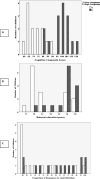Preschool language variation, growth, and predictors in children on the autism spectrum
- PMID: 25753577
- PMCID: PMC4565784
- DOI: 10.1111/jcpp.12406
Preschool language variation, growth, and predictors in children on the autism spectrum
Abstract
Background: There is wide variation in language abilities among young children with autism spectrum disorders (ASD), with some toddlers developing age-appropriate language while others remain minimally verbal after age 5. Conflicting findings exist regarding predictors of language outcomes in ASD and various methodological issues limit the conclusions that can be drawn about factors associated with positive language growth that could provide insights into more effective intervention approaches for increasing communication skills.
Methods: Language development was investigated in 129 children with ASD participating in four assessments from mean age 2½ years (Visit 1) through 5½ years (Visit 4). Language ability was measured by a clinician-administered test of comprehension and production. Hierarchical linear modeling was used to identify predictors of language ability. Stability of language status was examined in subgroups of Preverbal versus Verbal children identified at Visit 1. Discriminant function analysis was used to classify another subset of cases according to Low Language (minimally verbal) versus High Language outcome at Visit 4.
Results: ASD severity was a significant predictor of growth in both language comprehension and production during the preschool period, while cognition predicted growth in production. For the highest and lowest language performers at Visit 4, cognition, maternal education, and response to joint attention correctly classified over 80% of total cases. The vast majority of children who were preverbal at 2½ years attained some level of verbal skills by 5½ years.
Conclusions: Findings indicate that it is possible, by 2½ years, to predict language growth for children with ASD across the preschool years and identify factors that discriminate between children who remain minimally verbal at 5½ years from those with high language proficiency. Results suggest that early intervention focused on reducing core ASD symptoms may also be important for facilitating language development in young children with ASD.
Keywords: Language growth; autism spectrum disorders; language predictors; minimally verbal; preverbal.
© 2015 Association for Child and Adolescent Mental Health.
Conflict of interest statement
Conflict of interest statement: S.K. has no conflicts of interest.
Figures

References
-
- American Psychiatric Association. Diagnostic and statistical manual of mental disorders. 4. Washington: American Psychiatric Association; 2000.
-
- Anderson D, Lord C, Risi S, DiLavore P, Shulman C, Thurm A, Welch K, Pickles A. Patterns of growth in verbal abilities among children with autism spectrum disorder. Journal of Consulting and Clinical Psychology. 2007;75:594–604. - PubMed
-
- Bayley N. Bayley Scales of Infant and Toddler Development. Third. San Antonio: PsychCorp; 2006.
-
- Ben-Itzchak E, Watson L, Zachor D. Cognitive abilitiy is associated with different outcome trajectories in autism spectrum disorders. Jouranl of Autism and Developmental Disorders. 2014;44:2221–2229. - PubMed
-
- Bopp K, Mirenda P, Zumbo B. Behavior predictors of language development over 2 years in children with autism spectrum disorders. Journal of Speech, Language, and Hearing Research. 2009;52:1106–1120. - PubMed
Publication types
MeSH terms
Grants and funding
LinkOut - more resources
Full Text Sources
Other Literature Sources
Medical

